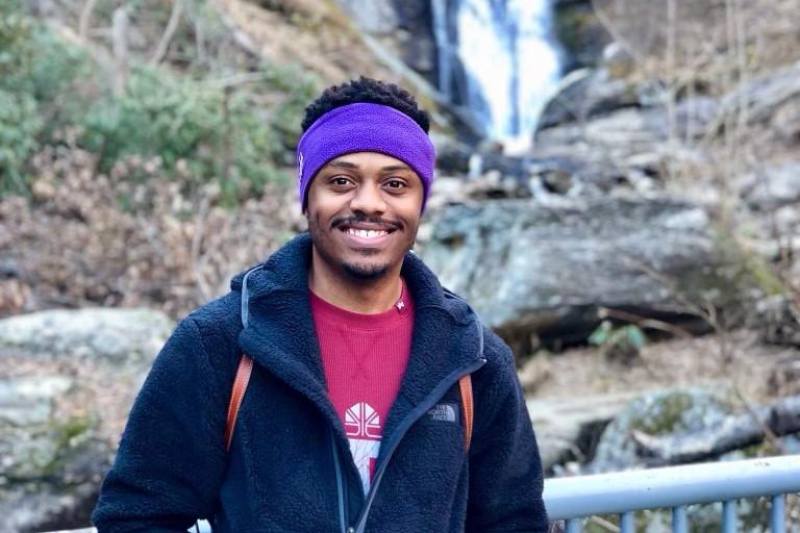Where did you grow up?
Growing up in a military family we moved around quite a bit. I was born in Naples, Italy where we spent 2 years, then moved to Jacksonville, Florida where we spent another 2 years. It was not until my father was stationed in Norfolk, Virginia that we finally got some stability.
I lived in Norfolk from the age of four until 15.
When my father retired from the Navy after 26 years of service, we moved to the small town of South Mills, North Carolina, located between Norfolk and Elizabeth City. North Carolina was a lot more rural than I was used to up to that point in my life, but I grew to appreciate quiet small-town living. Almost 15 years after moving to North Carolina, my parents continue to commute to and from Virginia for work.
Where did you go to school and in what subject did you get your degree(s)?
I attended Elizabeth City State University, a historically black college/university (HBCU) in Elizabeth City, North Carolina. While there I was an undergraduate research assistant on a submerged aquatic vegetation project. I studied the effects of climate change on the growth and germination rates of multiple species of SAVs. In 2014, I obtained my bachelor of science in marine environmental science.
I was then accepted into the Marine Estuarine Environmental Science Graduate Program at the University of Maryland Eastern Shore, another HBCU. My master’s thesis focused on the stranding demographics of marine mammals in Maryland and inorganic contaminants in the livers and kidneys of bottlenose dolphins. In December 2016, I received my master of science degree in marine estuarine environmental science, with a focus on marine ecology.
How did you come to work at the Northeast Fisheries Science Center?
My love for the sea was developed early on, having grown up around the water. In grade school when my peers aspired to be police officers and astronauts, my dream was always to study the ocean. Having a job with the federal government could be considered the American dream. My desire to be a marine scientist at NOAA was the obvious goal.
In 2013, I had the privilege of participating in the Woods Hole Partnership Education Program. I interned at the Northeast Fisheries Science Center with Frederick Wenzel in the Protected Species Branch, studying the feeding ecology of the gray seal. While in graduate school I was fortunate enough to be able to study and conduct work at both the Cooperative Oxford Laboratory in Oxford, Maryland as well as the Hollings Marine Laboratory in Charleston, South Carolina. My graduate research was funded by NOAA’s Living Marine Resources Cooperative Science Center, a program dedicated to preparing its students for the NOAA workforce. I also participated in NOAA’s Education Partnership Program.
After graduating, I spent two and a half years working for the North Carolina Division of Marine Fisheries as a protected species observer. I worked onboard commercial and recreational fishing vessels and alternative platform vessels throughout the estuarine waters of North Carolina. I moved on to the North Carolina Division of Coastal Management as a field representative. That position involved conducting on-site inspections, field reviews, and wetland delineations of proposed projects (e.g., boat ramps, bridges, houses) to ensure compliance with the Coastal Area Management Act.
Because of my knowledge, experience, and involvement in so many NOAA partnered programs, I was able to apply for a position at the Northeast Fisheries Science Center through their Talent for the 21st Century Program.
What do you do at the Science Center?
I am new to the science center. Currently, I am a fish biologist for the Oceans & Climate Branch in Narragansett, Rhode Island. I am working on developing a database of longfin squid para-larval abundance from archived samples. The samples were collected in two long-running programs: the ongoing Ecosystems Monitoring Program, and the Marine Resource Monitoring and Prediction program, which ran from 1977 through 1987. The goal is to re-evaluate squid life history and stock structure and to determine if bottom trawling affects egg mortality in this species. A large amount of this research is done by identifying and measuring para-larval squid under a dissection microscope.
What do you like most about your position?
Working for the Oceans & Climate Branch has been a great experience so far. It allows me to meet (virtually, of course) and work with a multidisciplinary group of scientists. I enjoy the ability to work on some of the most important fisheries in the region. In this unprecedented time, there have been many challenges and we’ve had to be innovative and flexible to overcome them. I enjoy thinking of new effective ways to get this done! My position also affords me the ability to engage in outreach opportunities.
What are some of your hobbies?
I love to read, but when my nose isn’t stuck in a book you will probably find me outside. I love the outdoors, especially the beach or hiking, but I also enjoy running and playing all sports. A couple of other little-known facts about me: I can ride a unicycle and have been playing the violin since I was 10 years old.





